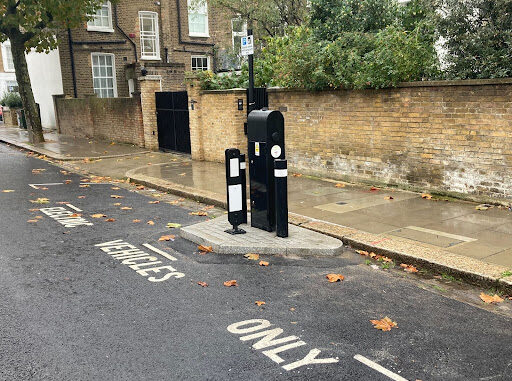Electric vehicle charge points ‘invading pavements’ claims new report
‘Streetspace invaders’ report says national rollout of electrical vehicle charge points (EVCPs) could be counterproductive and jeopardise walking and wheeling targets. It also highlights serious accessibility problems.
The study is directly relevant to anyone in the country involved in electric vehicle infrastructure. It focuses on London as the capital is so far ahead of the rest of the country in deploying new electrical vehicle charge points (EVCPs) and compares the different boroughs’ strategies using information obtained through Freedom of Information requests.

A kerb buildout EVCP installed in a parking bay in London, photo courtesy of Possible.
‘Streetspace invades – mitigating the growing risk that EV charging poses to scarce pedestrian space’ has been complied by Leo Murray, Director of Innovation and Engagement at climate charity Possible, and produced with support from cycling charity Wheels for Wellbeing.
Notably, the report says that the quality of data provided by boroughs was relatively poor and sometimes clearly incorrect. ‘In every instance where data provided by boroughs was wrong, it [the borough] had underestimated the number or the share of EVCPs installed on footways.’
Best practice guidelines already advise that new charging point should be installed in a parking bay rather than on the pavement.
But, says the report, installing an EVCP in a park space requires a statutory consultation process that takes time and money. Ironically, EVCPs and other equipment to service drivers can be installed on footways without either consent of consultation – so it’s no wonder that is what’s been happening.
Across London, at least 2,453 EVCPs have been installed on footways. That is nearly four times as many as the 620 installed on ‘kerb buildouts’ in the road.
Hammersmith & Fulham is the only London borough with a policy to always site EVCPs on footways rather than kerb buildouts. Of those, three quarters do not leave 2m space for pedestrians while nearly 40% fail to leave the 1.5m space need to allow a wheelchair user and pedestrian to pass.
But there is praise for Hackney, which has issued a procurement order which for its next wave of installations that specifies kerb buildouts. Wandsworth has also committed not to install any more chargers on the pavement, and Lambeth and Camden are also commended for their strategies.
This has wider implications for EVCP rollout across the country. Many local authorities are expanding the number of EVCPs available in their areas. What’s more, the newly formed industry association ChargeUK announced that it will provide £6bn investment for new charging points by 2030.
The report doesn’t question the need for more charge points. It questions how this is being done, whose needs are being prioritised and what will be achieved.
It says: ‘The invasion of pedestrian space by a new breed of private motor car in the name of the environment is an important physical manifestation of a more fundamental philosophical challenge to our societal response to the climate crisis. Many people prefer to believe that an effective response can be mounted exclusively off the back of technological change. But across many areas of life, not least transport, this is not what the evidence suggests.
‘There is a growing expert consensus that electrification of our road vehicle fleet will not be sufficient to meet our national climate commitments on its own; a large and rapid absolute reduction in vehicle miles driven on our roads will also be required.’













Leave a Reply